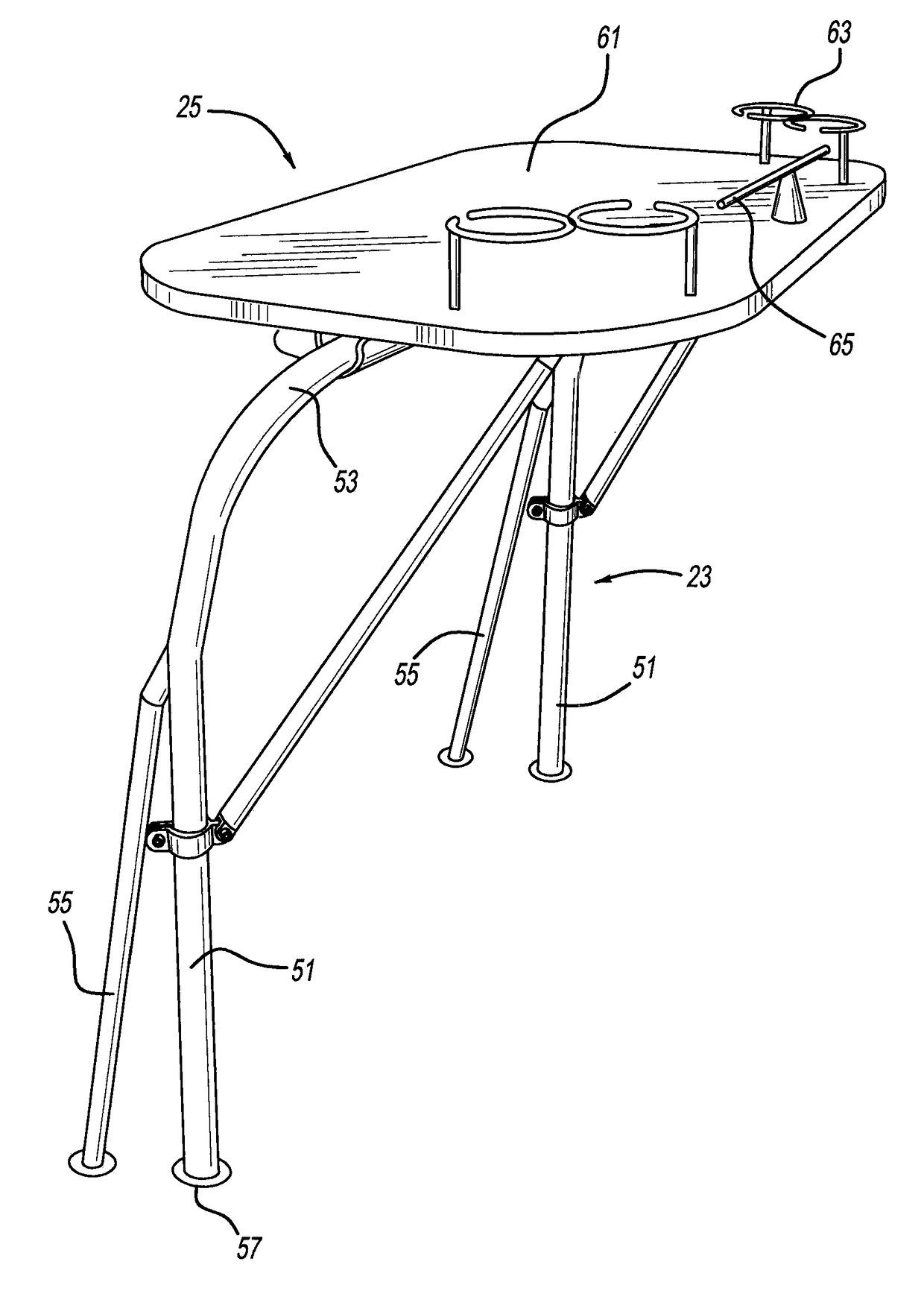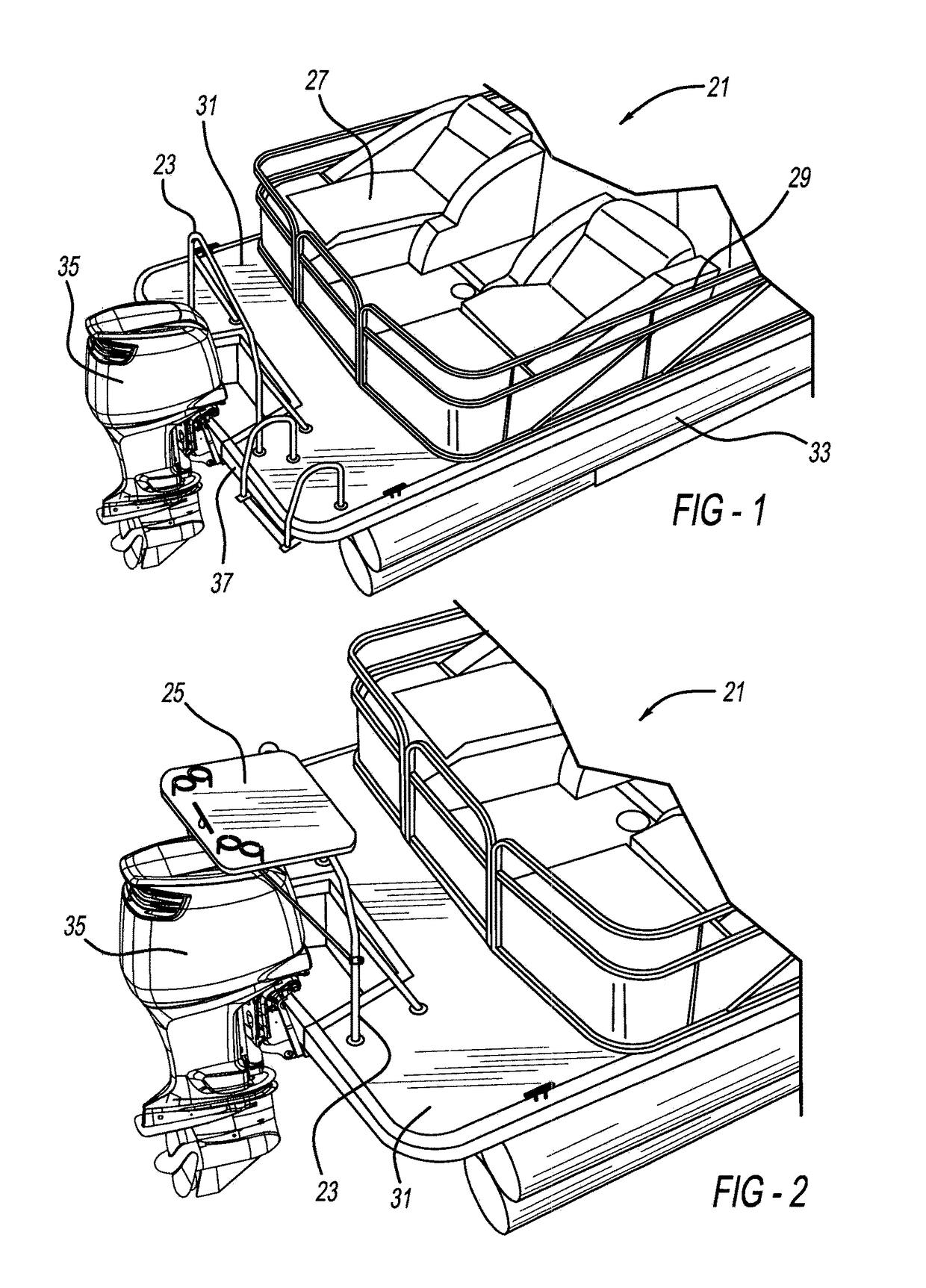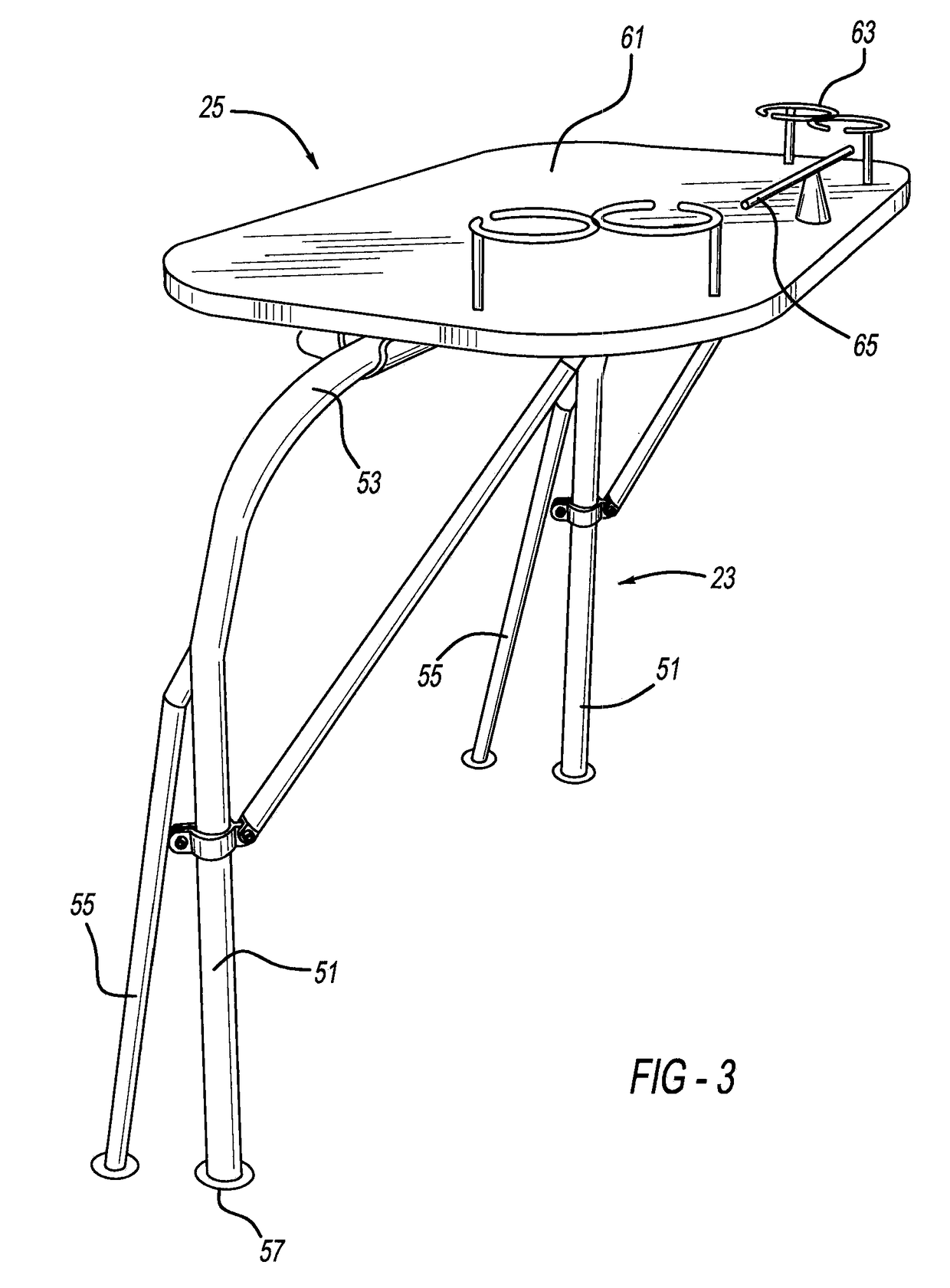[0005]The boat table of the present invention is advantageous over conventional devices. For example, the present boat table is ideally suited for use with pontoon boats without obstructing the seating area thereof. The present boat table is also advantageous by being mounted to a ski rope tow bar, but without obstructing access of a ski rope attached thereto, thereby providing a multifunctional assembly. This reduces cost, is aesthetically improved by covering the conventional structural appearance of ski rope tow bars, and provides a functional table surface in a previously unused area. In another aspect, a side rail mounted table advantageously can be removeably mounted with a foot engaging between existing structural members of a pontoon boat, thereby saving cost, parts and deck space. Moreover, the present table beneficially supports beverage cups and plates for the boat occupants in an aesthetically pleasing manner but again, without encroaching upon the normally used deck space of a pontoon boat. The table adds previously unused article retention space of at least 10 ft2. Additional advantages and features of the present invention can be ascertained from the following description and appended claims, as well as in the accompanying drawings.BRIEF DESCRIPTION OF DRAWINGS
[0036]It is noteworthy that the present ski rope tow bar and table assembly are positioned and constructed such that at least a majority of table 25 extends outboard of deck 31 of the pontoon boat thereby allowing the boat occupants to walk between the seating area and the table with minimal, if any, obstruction. Moreover, the present configuration advantageously positions at least a portion of table 25 above outboard motor 35 while still allowing for normal movement and tilting of outboard motor 35 relative to the boat without being impeded by the table. This beneficially provides multifunctional use of the ski boat tow bar for water ski tow rope attachment while the table remains in place.
[0040]Reference should now be made to FIG. 9. A different embodiment of a ski rope tow bar 423 is configured as a vertically elongated and cylindrical post which can be removeably inserted into a cup-like receptacle 461 in deck 431. A mounting bracket 473 has a cylindrical and hollow sleeve 475 for fitting around an upper end of tow bar 423 while a flange 477 is screwed into an underside of table 425. A cotter pin, bolt or other fastener may be horizontally inserted through an external hole in sleeve 475 and received within a matching hole or undercut of tow bar 423 to secure the two together. Additionally, a water ski tow rope 471 can be inserted into a hole in sleeve 475 for securing to tow bar 423. It is again noteworthy that table 425 is positioned outside of the normal seating area of the pontoon boat while also advantageously allowing the multifunctional use of tow bar for attachment by the ski rope.
[0047]Reference should now be made to FIGS. 21 and 22. A flexible cargo support 901, such as a net includes a webbing of nylon or other polymeric fabric straps formed in a repeating crossing pattern. This flexibility allows for adjustment to hold any existing sized, portable cooler within the dimensions of the tow bar. Flexible steel or aluminum rods 903 reinforce sections of net 901 and are located within pockets or loops of some of the straps in a spaced apart manner. The net can be moved forward without detachment when motor tilting is desired, when the cooler is absent. Alternately, support 901 may be a moveable or fold-down rigid shelf pivotably coupled to vertical members 51 by clamps such as that shown in FIG. 10. Alternately, support 901 can be a flexible woven fabric sling or thin polymeric sheet. For many boats, motor mounts including motor fuel lines and steering mechanisms are located in the area below the table and forward of the motor so a cooler cannot be placed on the deck at this area. Thus, the present support 901 beneficially spaces the cooler above the motor mounting area and deck to maximize the useable deck space. Alternately, a storage box or container for holding bumpers or other parts can be used in place of the cooler storage container.
[0048]Elongated and somewhat flexible guides 905 have a generally L-shape and are secured within end loops or pockets at the outboard sides of net 901. A lower and forward end of each guide 905 is removeably coupled to support member 55 via a bracket 907 and bars 903, such as like 1024 and 1053 of FIG. 23. A holding area of net 901 is accessible from the front such that a beverage cooler 921 can be placed thereon offset spaced above the deck (with a gap therebetween), in otherwise unused space between the vertical members of the tow bar. This provides synergistic benefits. Flexible and adjustable length straps 923 have hooks 925 on ends thereof for removeable engagement with handles 927 of cooler 921. Straps 923 are looped around or riveted to upstanding structural members 51. Alternately, a light gage and non-stretchable chain or wire, with a hook, will attach to post members 51 and through cooler handles 927 to deter lateral motion of the cooler.
[0049]FIG. 23 illustrates another embodiment of a table 1025 coupled to a telescopically extendable pair of generally horizontal bar members 1053A and 1053B. Members 1053A and 1053B are coupled to generally vertically extending post members 1051 of a ski rope tow bar 1023, by vertically adjustable brackets or clamps 1024. A pair of perpendicularly accessible U-brackets 1073 couple bar members 1053A and 1053B to fore-and-aft elongated rails 1067 mounted to a top surface of table 1025, allowing for fore-and-aft adjustability of the table relative to the tow bar. Diagonal struts 1091 couple a bottom of table 1025 to vertical members 1095 via adjustable clamps 1095.
 Login to View More
Login to View More  Login to View More
Login to View More 


